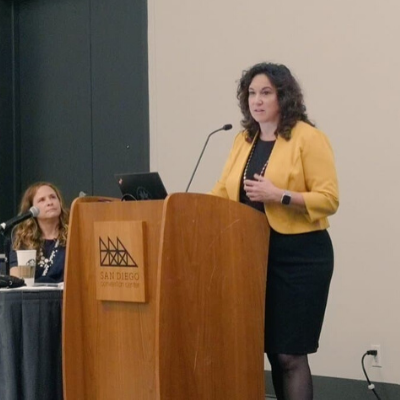It’s fairly common knowledge: healthier students are better learners. But are districts doing enough to build a culture of wellness in their schools?
“As educators, we see the strong relationship between students’ health and learning,” said Cindy Marten, superintendent of the San Diego Unified School District. “But our mission cannot be accomplished without explicitly planning for and supporting student health and wellness.”
Marten joined her colleague from the district, Wellness Program Supervisor Kate McDevitt and Nancy Katz, senior director for the Alliance for a Healthier Generation, for a wellness-focused presentation “Improving Student Success with Healthy School Environments” at AASA’s national conference on Saturday.
Katz pointed to physical activity as one of the most important factors that often goes overlooked when it comes to improving student outcomes.
“We know that students who are physically active have better grades, school attendance, performance, and classroom behaviors,” Katz said. “But there are lot of social-emotional skills that are learned through physical activity. Beyond just thinking, ‘oh, let’s get the kids out there to exercise,’ keep in mind there is a lot of learning that occurs on the playground.”
Katz emphasized that exercise, while essential, is just one of several things schools need to consider. Nutrition, healthy sleep habits, social and emotional learning supports, and family interaction are all key components of a well-rounded approach to wellness, she said.
Even if schools are able to address all of these areas, many are not seeing the benefits due to overly bureaucratic processes or disconnection between departments.
“We’ll see that a lot of things are happening, but they're often not happening in a cohesive or efficient way,” Katz explained. “The staff in different departments dealing with nutrition, physical education, nursing─ they may not be connected to each other.”
McDevitt also noted the challenges to developing a healthy learning environment, drawing on her experience of implementing a new wellness program for California’s second-largest school district.
“In a journey towards wellness, you have to start somewhere,” McDevitt said. “In 2012 we had a wellness policy but it was only one paragraph. We had a lot of work to do, so we brought people to the table and created a new policy for what wellness should look like in San Diego schools.”
Coming up with a plan is just the start; putting it into action is another challenge entirely.
“Moving your policy from a document just sitting on a shelf into meaningful implementation requires strong support from leadership, and broad involvement,” McDevitt said. “Fortunately our superintendent and our school board decided to make an investment in wellness.”
For San Diego Unified, that investment meant appointing a site-based “wellness coordinator,” trained by the district, at every school. The coordinator forms a wellness committee at their campus that then creates and takes on projects to support student wellness through exercise, nutrition, family engagement and more, sharing best practices with other sites throughout the district.
Of course, an effective wellness policy also needs to support staff well-being, too, school officials say.
“You can't take exquisite care of other people if you aren't doing that for yourself,” said Marten, who oversees roughly 14,000 employees as superintendent. “We have to focus on our employees’ well-being and their needs, so they can focus on that of their students.”
Marten said spending 17 years as a teacher taught her the importance of self-care, and how educators in particular can benefit from daily wellness practices.
“Teachers are having to work with students and families in communities that have extreme challenges,” Marten said. “We can't always know what our employees need for their own wellness journey, but we can let them know they have supports.”
By 2019, at least half of employees were participating in site-based wellness events at a majority of the district’s schools.
The efforts appear to have paid off.
In the first three years of its new wellness initiative, San Diego Unified was recognized twice as a gold-level awardee for Workplace Achievement by the American Heart Association, and also received several “America’s Healthiest Schools” awards.
Closing out the session, Marten encouraged school leaders in attendance to make a small wellness commitment of their own.
“Hopefully you are doing something for your wellness while you're in San Diego,” she told the audience. “The AASA conference is here in one of the country’s most beautiful cities, so I encourage you ─ walk around and explore. Get outside and move around!”
(Dan Howe is the public information supervisor for San Diego Unified School District.)


